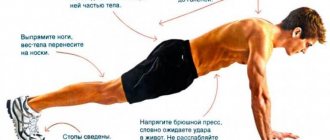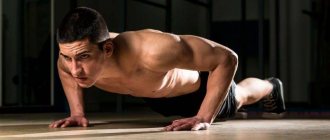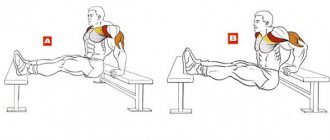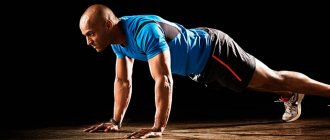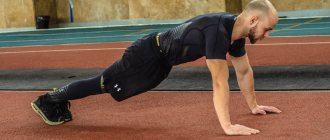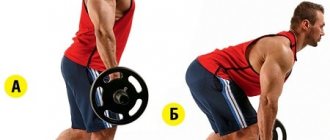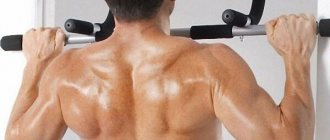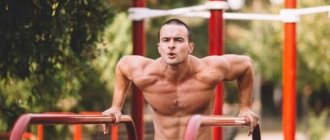One-arm push-ups are a technically challenging and quite impressive exercise that can clearly demonstrate the physical skills of an athlete. To learn how to do push-ups in this way, it is important to have a certain physical training, as well as the ability to maintain balance through the work of stabilizing muscles. It is also very important to know how to properly do push-ups on one arm, and not to violate this technique.
Benefits and Benefits of Exercise
The exercise is beneficial because it helps develop strength and endurance in the muscles of the upper body. One-arm push-ups work the same muscles as classic push-ups, but they also have certain differences, which include the following:
- The load is placed on only one hand. Because of this, the intensity of muscle work will be twice as great as with classic push-ups. This exercise can only be performed by a really strong athlete.
- In addition to a fairly large load on the muscles, when performing this exercise we need to maintain balance, which will be quite difficult. You will have to use all the core muscles. It will be especially difficult to maintain balance while moving. This, of course, is much more difficult than classic push-ups, so the benefits of the exercise for muscles are higher. And in order to withstand this kind of load, you need to use the muscles of almost the entire body.
This challenging workout strengthens muscles and ligaments, increasing endurance and agility. Regular exercise makes it possible to eliminate excess weight and improve metabolism, improve the respiratory system, and strengthen bones. But for the exercise to bring only benefits, it is important to master its correct technique and not overdo it with the number of repetitions.
Handstand push-ups
One of the most difficult types of push-ups is the handstand push-up. This exercise is designed to develop the upper body and involves the chest, shoulders and triceps.
No additional equipment is required to perform the exercise. If you learn to do 3 sets of 15 times this way, you will notice how much your shoulder girdle will change in the direction of growth and strengthening.
Correct performance of push-ups while standing on your hands:
- Bend over, place your hands on the floor shoulder-width apart.
- Push off the floor with your feet and stand with your arms fully extended. You can touch the wall with your feet.
- The body and legs must be kept straight throughout the entire exercise.
- Your gaze should be directed at the wall, not the floor.
- You should lower yourself slowly until your head touches the floor. Just as slowly you need to straighten up.
- Low execution speed is the key to success. If you rush, you can easily get injured.
When performing push-ups while standing on your hands, the following muscles are used:
- Deltoid;
- Supraspinatus muscle;
- Trapezoid;
- Triceps;
- Top of the pectoral muscle;
- Serratus anterior;
- Coracobrachialis muscle.
You should not do too many repetitions of this exercise: staying upside down can have a negative impact on your health.
One-arm push-ups: technique
One-arm push-ups can be performed using different techniques. Various sources present different variations of the exercise. Some of them are more complex and effective, others are simpler and more suitable for beginners.
First, we will consider the most complex, standard technique of push-ups on one arm, and then we will present simpler, prepared options.
In the standard version, the position of the body during the movement will be almost the same as with classic push-ups. Only you will need to lean not on two palms, but on one, which will be placed under the body. In other words, your body will be in a completely straight line, your shoulders will be parallel to the floor, and your feet will be shoulder-width apart. This is a technique that you need to strive for, but it is unlikely that anyone will be able to do push-ups like this right away, even with impressive physical strength. The reason for this is that balance and the ability to coordinate the work of many muscles to perform the exercise will not be enough.
Here's how to ideally do push-ups on one arm:
- Take the starting position, namely, lying on one hand. The other hand is placed behind the back, the hand is placed on the buttock or slightly lower. The body should be straight, legs should be on their toes. Let your feet stand shoulder width apart or slightly wider.
- Inhaling, bend your working arm at the elbow and lower your chest almost to the floor. At the same time, pay attention so that the lower back does not bend.
- Exhaling, push yourself to the starting position .
Pay attention to techniques that will help make the exercise easier:
- If you spread your legs wider, it will be easier to maintain balance, and then you will be able to move your working arm further from the midline of the body. As a result, a lot of the load will be transferred from the triceps to the chest muscles.
- Balancing will become easier if you move your pelvis toward your working arm and lift your opposite shoulder.
The techniques listed above should be used only at the beginning of training, when you are just mastering the technique. Otherwise, you may get used to this lightweight option and will not progress in the future.
Execution technique
Different trainers have their own techniques for doing push-ups with one arm. They are quite varied and suitable for athletes of varying levels of training. Some exercises are difficult to perform, but are more effective for pumping muscles. Other techniques are easier to perform, they are suitable for beginners, and their effectiveness will be lower.
In this version of the exercise, the body should be in the same position as with classic push-ups with some features:
- there will be three support points, instead of four, they should be placed in the form of a triangle;
- the working hand is placed under the body;
- the body from the heels to the crown should be straight;
- the shoulders are at the same level during the exercise and are parallel to the floor;
- feet stand shoulder width apart, as close as possible.
There are general requirements for push-ups with an emphasis on one hand, the basic technique for performing which is as follows:
- Starting position – the working hand is under the shoulder, closer to the middle of the chest, the legs are on their toes at a distance of shoulder width or slightly wider, the back is straight. The other hand can be placed with the palm on the buttocks or the back of the thigh.
- As you inhale, bend your working arm at the elbow, lowering your chest as low as possible. Ideally, at the lowest point the chest should be no higher than 10 cm from the floor. When lowering and ascending, bending at the lower back or “walking” with your shoulders is prohibited.
- Straining the muscles of your arms, push yourself to the starting position. Exhalation.
No one succeeds in lowering themselves “with their chest touching the floor” the first time. First you need to start lowering a few centimeters and not fall. You need to gradually lower the level of your “bottom point” until your chest is 10 cm from the floor.
It will be much easier to maintain balance if the pelvis is shifted towards the working hand, and the shoulder of the free hand is raised. This option is suitable for beginners in push-ups. Getting used to this method of training will not give good results, and such a technique will not be counted in competitions.
One-arm push-ups: types
Learning how to do one-arm push-ups from scratch is not so easy due to the complexity of the exercise, and regular training is required. Therefore, it makes sense to start with a set of preparatory exercises that will help prepare your body for that very standard push-up technique.
Partial support on the second hand
For this exercise you will need some kind of support - a ball, a block or something else. In this case, we will do push-ups as follows:
- First you need to take a lying position. The arm, which in the classic version of the exercise is placed behind the back, should be straightened and moved to the side. The palm should be placed on a support. You will not be able to fully lean on it, however, you will receive partial support, and this will make it easier for you, and besides, you will not touch the floor with this hand.
- Do push-ups, focusing on the strength of the supporting arm muscles.
These push-ups are easier than one-arm push-ups, but more difficult than classic push-ups. Over time, try to transfer the weight of your entire body onto your working hand, and gradually lift the other one away from the support.
Second hand on the back
This exercise will also help you learn how to do push-ups on one arm. Take the standard version for push-ups, but place the palm of your working hand on the floor, as in the usual version, and place it in the palm of your other hand on the back side. Doing push-ups on the back side is quite difficult and uncomfortable, so involuntarily most of the weight will be transferred to the working hand. The technique will be as follows:
- You need to take the classic push-up position. Place the palm of one hand on the back side, and transfer the body weight to the other hand.
- Start doing push-ups, while trying to fully concentrate your efforts on your active arm.
Hands above feet
This exercise reduces the load on the working arm, so the muscles can get used to the work. It is performed as follows:
- Place your working hand on a slight elevation. This could be a step platform, a bench or the edge of a bed. This will reduce the load on the muscles, and therefore focus as much as possible on how to work on balance.
- Place your other hand behind your back and straighten your torso.
- Try to perform the movement with proper technique, bending only the active arm.
When you learn to do push-ups in this position, the height of the support can be gradually reduced, thus lowering towards the floor. The good thing about this exercise is that you can immediately learn how to maintain balance.
There is a particularly masterly option - push-ups on one finger, which certainly is not suitable for those whose physical fitness cannot be called good. Yes, doing push-ups on one finger is quite possible, but athletes approach this gradually: first they do push-ups on four fingers, then on three fingers, and so on. Please note that the load on the fingers in this case is enormous, so preparation and gradualness are very important here.
Contraindications and precautions
Although the exercise is very difficult, it has quite a few contraindications. Essentially, they are the same as in the case of regular push-ups. Thus, exercise is prohibited for injuries in the shoulder, elbow, or wrist joint.
Hold off on one-arm push-ups until you feel any pain or discomfort in your muscles or joints. Otherwise, the benefits of the exercise may be negated, but there can be quite a lot of harm.
In addition, your physical fitness plays a role. If you are new to the sport, you should not start with one-arm push-ups. First, it is recommended to master classic push-ups, and then gradually approach your goal - how to learn to do push-ups on one arm. To ensure that the exercise brings you only benefit, consider the following recommendations :
- You should not experiment with transferring the load to one hand until you can, with the correct technique and easily, do at least 30 regular push-ups on both hands. You need strong shoulders and triceps to perform this exercise, especially if you are fairly heavy.
- To gain the necessary core strength, you can do push-ups on your elbows, while trying to use the one-arm push-up technique.
- If you get tired with only a few reps left in your set, be patient and push through to the end. Pushing yourself in this way is the best way to train your muscles, and in the future they will thank you for it.
- It's normal to be tired, but if you feel like you can't continue at all, stop. If your arm cannot support the load placed on it, you may fall and hit your face on the floor.
If you suddenly feel a sharp, severe pain, you should also stop. And if the pain does not stop, it is important to consult a specialist, as there are risks of injury.
Benefits, harms and contraindications
Before you learn how to do push-ups on one arm, we will look at the advantages and disadvantages of the exercise, as well as its contraindications.
Benefit
- The athlete develops unprecedented strength;
- Trains endurance of the upper body muscles;
- Builds spectacular relief of the upper limbs;
- Trains coordination and balance;
- Works your abs and strengthens your back muscles.
Harm
Let's continue to study one-arm push-ups, the benefits of which have been discussed. Next, let's move on to the possible harm that may occur if you perform the exercise with contraindications:
- Joint injury: wrist, elbow, shoulder;
- Any pain in the muscles;
- Inflammatory processes accompanied by increased temperature;
- Exacerbations of chronic diseases;
- Conditions after abdominal surgery, heart attack, stroke, radiation.
If you neglect contraindications, the body will not only not experience any benefit, but will also suffer - you can worsen your condition.
Flaws
- Difficulty of implementation;
- Risk of injury (beginners may not be able to maintain balance);
- The need to do push-ups in the company of a partner (for beginners, for safety net).
One-arm push-ups: video
One-arm push-ups, we already know which muscles work when performing them, are a difficult exercise, but it’s worth it. The exercise is not easy both physically and in terms of coordination, but athletes know that nothing is impossible. And if you manage to master this version of the exercises, you can easily prove that your level of training is up to par. And the video of one-arm push-ups, which you will find below, will help you master the correct technique.
